A condition that has difficulty with screening and is frequently misdiagnosed is carpal tunnel syndrome. Because it resembles the signs and symptoms of other conditions, it often misdiagnosed. We’ll examine the two disorders that are frequently incorrectly identified as carpal tunnel syndrome in this post. Learn what carpal tunnel syndrome is first.
What is carpal tunnel syndrome (CTS)?
The wrist contains a small opening called the carpal tunnel. It is a tiny, tunnel-like structure. The transverse carpal ligament and the carpal bones at the base of the hand are responsible for its creation. The median nerve and the tendons of the several muscles that regulate finger movement are among the vital components that the carpal tunnel protects.
The following are the main elements of the carpal tunnel:
The median nerve, which extends from the forearm into the hand, is a significant nerve in the arm. The thumb, index finger, middle finger, and part of the ring finger are all sensed by it.
Flexor Tendons: A number of tendons that attach to the forearm muscles are located within the carpal tunnel. They regulate how the thumb and fingers move. Your fingers flex and enable you to hold objects thanks to these tendons.
One of the prevalent medical diseases affecting the wrist and hand is Carpal Tunnel Syndrome (CTS). It happens when there is compression of median nerve, which extends from the forearm into the hand, when it travels through the carpal tunnel, a small opening in the wrist. Factors such as wrist injuries, repetitive hand movements, or underlying medical disorders that cause swelling and inflammation in the wrist could be the cause of this compression.
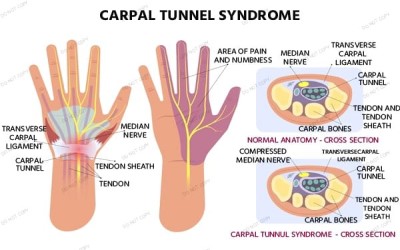
Signs & Symptoms of Carpal Tunnel Syndrome:
- Numbness and tingling: Numbness, tingling, or a “pins-and-needles” sensation are common symptoms in the thumb, index finger, middle finger, and part of the ring finger in people with CTS.
- Weakness: As the illness worsens, the hand may get weaker, making it harder to grasp items for extended periods of time, grip objects, or execute fine motor activities.
- Piscomfort: In certain people, it can produce discomfort in the wrist, palm, and fingers, which can then spread up the forearm and even to the shoulder.
- Symptoms at night: A lot of people with CTS report that their symptoms get worse at night. Their hands might hurt or feel numb when they wake up.
Two conditions that are often misdiagnosed as carpal tunnel syndrome:
Arthritis and thoracic outlet syndrome are the two conditions that are often misdiagnosed as carpal tunnel syndrome.
I. ARTHRITIS
Rheumatoid arthritis, gout, and osteoarthritis are examples of arthritic conditions. While not the same as carpal tunnel syndrome, all of these rheumatic disorders share some similar signs and symptoms. Let’s contrast carpal tunnel syndrome with all other arthritic conditions:
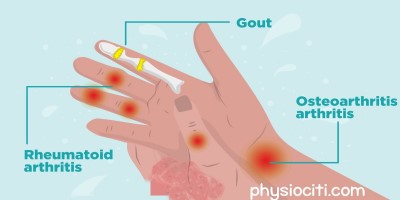
Carpal Tunnel Syndrome (CTS):
- Location of Symptoms: The wrist and hand are the main areas affected by CTS. Usually, the palm, thumb, index finger, middle finger, and half of the ring finger are the main areas.
- Numbness and Tingling: Numbness and tingling are two of the most common symptoms of CTS. It frequently manifests in the previously mentioned fingers as a “pins-and-needles” feeling. It’s possible for the forearm to feel the same way.
- Characteristics of Pain: Pain with CTS is usually throbbing or scorching, and it may come and go. It is brought on by repeated hand motion activities like typing and clutching.
- Weakness: One common symptom of CTS is hand weakness. It may become difficult to hold things or carry out delicate duties.
- Diagnostic Tests: To evaluate median nerve function and compression, clinical tests such as Tinel’s sign, Phalen’s test, NCV, and EMG are used
Osteoarthritis of the Hand/Wrist:
- Location of Symptoms: Hand and wrist joints are among the joints commonly affected by osteoarthritis. The joints that are impacted by this typically experience pain and stiffness.
- Joint Stiffness: Osteoarthritis can result in stiff joints, particularly first thing in the morning or after prolonged periods of inactivity. With joint movement, the stiffness usually becomes less severe.
- Swelling and Enlarged Joints: Osteophytes surrounding the afflicted joints, joint swelling, and discomfort are common side effects of arthritis.
- Diagnostic Tests: Diagnostic tests include physical examinations, medical histories, imaging studies such as MRIs, ultrasounds, and X-rays, as well as clinical evaluations. These are essential for evaluating arthritic symptoms, cartilage loss, and joint degeneration.

Carpal tunnel syndrome v/s OA:
To differentiate between CTS and osteoarthritis in the hand and wrist:
- Consider the location of the symptoms:OA affects the afflicted joints in the hand and wrist, whereas CTS affects the wrist and hand.
- Note the nature of the pain and stiffness: CTS discomfort is usually aching or painful, and it usually comes with tingling and numbness. Pain from osteoarthritis is typically felt in the afflicted joints. Its defining attribute is a stiffness that gets better with movement.
- Cause: Because RA is an autoimmune disease, the synovium is attacked by the body’s immune system. The hands, wrists, and other joints throughout the body become inflamed as a result of this inflammatory reaction.
- Symptoms:
- In RA, joint stiffness, discomfort, and edema are typical. Usually impacting joints on both sides of the body, this discomfort is symmetrical.
- One of the main symptoms of RA is morning stiffness that lasts for more than an hour.
- Not just hands and wrists, but other joints can also be afected by RA. Additional symptoms including fatigue and systemic inflammation could be present.
- Diagnostic Tests: It involves clinical assessment, medical history, physical examination, and blood tests for anti-cyclic citrullinated peptide (anti-CCP) and rheumatoid factor (RF). Joint inflammation and injury can also be evaluated with imaging tests like MRIs and X-rays.
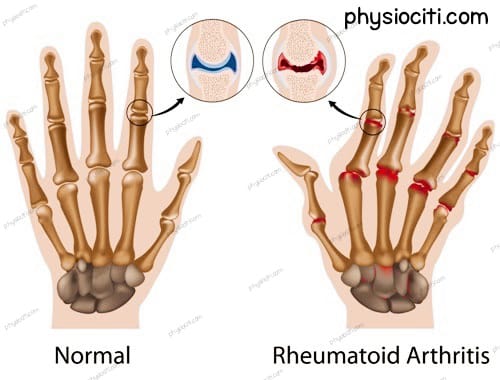
Carpal Tunnel Syndrome v/s RA:
To differentiate between CTS and RA in the hands and wrists:
- Consider the distribution of symptoms: While RA affects many joints, typically symmetrically, and may also affect joints in other parts of the body, CTS symptoms are limited to the wrist and hand.
- Nature and duration of pain and stiffness: CTS pain is typically occurs in the wrist and hand and is usually aching or burning. On the other hand, morning stiffness is one of the main symptoms of RA, along with edema, joint stiffness, and systemic symptoms.
Gout:
- Location of Symptoms: The big toe is the joint that is most affected by gout, though it can also affect other joints. It is a type of inflammatory arthritis brought on by uric acid crystal accumulation in the joints.
- Cause: caused by uric acid crystals accumulating in the joints. Usually, the condition occurs when the body cannot properly excrete uric acid or produces excessive amounts of it.
- Pain Characteristics: Gout is characterized by sudden and excruciating pain in the affected joint or joints. The discomfort normally starts quickly and is often unbearable, especially at night.
- Swelling and Redness: Warmth, redness, and swelling in the affected joint are signs of gout episodes.
- Duration of Symptoms: A gout episode can last for a few days or perhaps a few weeks. The affected joint may return to normal in between attacks.
- Risk Factors: Gout is associated with heredity, dietary variables (eating foods high in purines), and medical diseases that alter the metabolism of uric acid.
- Diagnostic Tests: Aspirating fluid from the afflicted joint and looking for uric acid crystals under a microscope provides a conclusive diagnosis of gout. Serum uric acid levels can also be determined by blood testing.
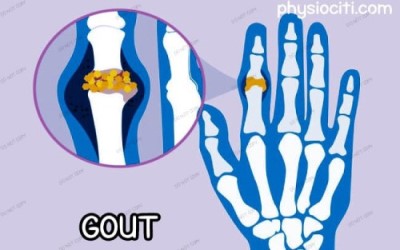
Carpal Tunnel Syndrome v/s Gout:
To differentiate between gout and carpal tunnel syndrome:
- Consider the location of symptoms: Gout primarily affects joints, while CTS affects the wrist and hand.
- Examine the nature and duration of pain: Whereas CTS pain is usually more chronic and presents as tingling and numbness, gout pain typically appears as sudden, acute, and episodic joint pain.
II. THORACIC OUTLET SYNDROME
Two different medical diseases, carpal tunnel syndrome (CTS) and thoracic outlet syndrome (TOS), can both produce symptoms in the upper extremities, especially the hands and arms. Even if they have certain characteristics in common, they can be distinguished from one another by their distinct causes, signs, and diagnostic characteristics:
Thoracic Outlet Syndrome (TOS):
- Location of Symptoms: The upper extremities, such as the hands and arms, the neck, and the shoulder can all be affected by TOS.
- Symptoms:
- tingling and numbness in the fingers, usually affecting the ring and pinky fingers.
- weakness in the arm and hand, especially when performing overhead tasks.
- Pain that can travel down the arm is felt in the upper chest, neck, and shoulder.
3. Arm Position: Certain arm movements or postures, such as raising the arms overhead or maintaining them up for extended periods of time, exacerbate the symptoms of TOS.
4. Types of TOS:
Vascular TOS: Two primary categories of TOS exist. The symptoms of one type of TOS, called vascular TOS, are caused by compression of blood vessels, such as arteries or veins, as they pass through the thoracic outlet.
Neurogenic TOS: The symptoms of the other kind of TOS, known as neurogenic TOS, are associated with compression of the brachial plexus, a network of nerves that regulates movements of the arms and hands.
5. Diagnostic Tests: In order to determine the precise form of TOS and its underlying reasons, the diagnosis of TOS typically involves a mix of clinical evaluation, medical history, physical examination, and occasionally imaging techniques like MRIs, X-rays, or vascular studies.
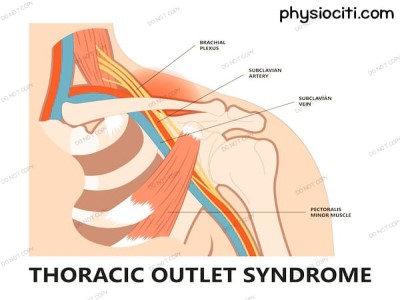
Carpal Tunnel Syndrome v/s TOS:
To differentiate between CTS and TOS:
- Consider the distribution of symptoms: Whereas TOS symptoms can also affect the neck, shoulder, and upper chest in addition to the arms and hands, CTS typically affects the wrist and hand.
- Note the triggering factors: While TOS symptoms may get worse with specific arm positions or activities, CTS symptoms are frequently seen with repetitive hand movements.
- Consult a healthcare professional: It’s important to get a medical assessment and diagnosis from a healthcare professional if you are suffering symptoms in your upper extremities. This professional can conduct the required tests and examinations to identify the underlying cause of your symptoms and suggest suitable treatment options.
Takeaway:
Two conditions that are often misdiagnosed as carpal tunnel syndrome were covered in this article. Thoracic outlet syndrome (TOS) and arthritis are these two conditions. Many of the signs and symptoms of these disorders are similar to those of CTS. It is challenging to diagnose with accuracy because of this overlap. Always follow medical advice from professionals to ensure a proper diagnosis and course of treatment.
ALL THE BEST!
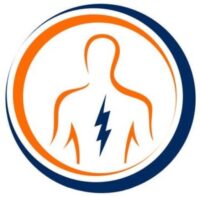

The therapists are very understanding and cooperative and the therapy sessions are also very interactive. I love taking therapy from this platform.
Your blog is amazing, I have never seen this type of explanation.